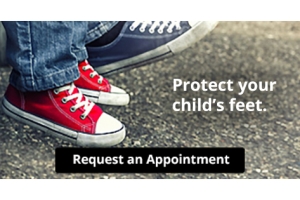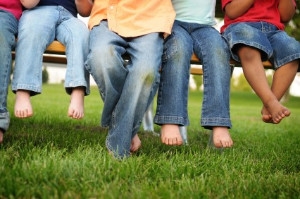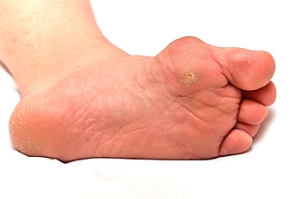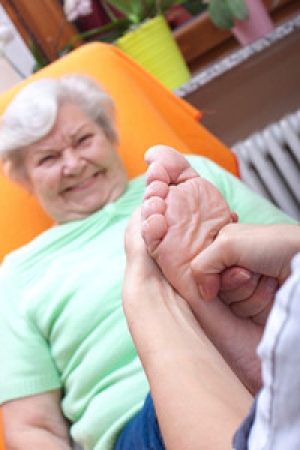
Blisters
Blisters are pockets of fluid that occur under the top layer of your skin. These fluid pockets are usually filled with pus, blood, or serum. Blisters may itch or hurt and can appear as a single bubble or in clusters.
The most common types of blisters are friction blisters. This type of blister may be caused by wearing shoes that are too tight. Friction blisters can also occur on the hands. A change in temperature may also cause blisters on the feet. In the freezing air, frostbite on your toes can lead to blisters, as well as sunburn from hot weather.
The best way to treat a blister is to keep it clean and dry. Most blisters will get better on their own. Once the skin absorbs the fluid within the blister, it will flatten and eventually peel off. You should avoid popping your blister unless you podiatrist does it for you. Additional treatment options include applying an ice pack to the blister or using over-the-counter blister bandages to cover the affected area.
If your blister becomes discolored, inflamed, or worsens it is advised that you speak to your podiatrist. Blisters that are yellow, green, or purple may be infected and require immediate medical attention. Blisters that are abnormally colored may be a sign of a more serious underlying health condition such as herpes.
How to Help Your Child Prevent Sporting Injuries
 If your child is active in sporting activities, it’s important to check and ask them if they are experiencing any kind of foot or ankle pain. Because their feet are still developing, they may run the risk of overworking their muscles or ligaments if the intensity of their sport is increased drastically. There are a few steps you can take to help prevent your child from having an injury. Most importantly, you want to be sure the footwear your child uses fits comfortably and that it is appropriate to the specific type of sport they play. You may also want to take note of the kind of surface your child practices on. For example, sports played on soft sand or grass can potentially lead to excess muscle activity, due to the ground’s instability. It may also be beneficial to encourage your child to space out their exercises or training to allow their feet and lower legs time to relax. For more recommendations on injury prevention, it’s suggested that you consult with a podiatrist.
If your child is active in sporting activities, it’s important to check and ask them if they are experiencing any kind of foot or ankle pain. Because their feet are still developing, they may run the risk of overworking their muscles or ligaments if the intensity of their sport is increased drastically. There are a few steps you can take to help prevent your child from having an injury. Most importantly, you want to be sure the footwear your child uses fits comfortably and that it is appropriate to the specific type of sport they play. You may also want to take note of the kind of surface your child practices on. For example, sports played on soft sand or grass can potentially lead to excess muscle activity, due to the ground’s instability. It may also be beneficial to encourage your child to space out their exercises or training to allow their feet and lower legs time to relax. For more recommendations on injury prevention, it’s suggested that you consult with a podiatrist.
Making sure that your children maintain good foot health is very important as they grow. If you have any questions, contact Dr. Robert Marcus of Foot & Ankle Center of Teaneck. Our doctor can provide the care you need to keep you pain-free and on your feet.
Keeping Children's Feet Healthy
Having healthy feet during childhood can help prevent medical problems later in life, namely in the back and legs. As children grow, their feet require different types of care. Here are some things to consider...
Although babies do not walk yet, it is still very important to take care of their feet.
Avoid putting tight shoes or socks on his or her feet.
Allow the baby to stretch and kick his or her feet to feel comfortable.
As a toddler, kids are now on the move and begin to develop differently. At this age, toddlers are getting a feel for walking, so don’t be alarmed if your toddler is unsteady or ‘walks funny’.
As your child gets older, it is important to teach them how to take care of their feet.
Show them proper hygiene to prevent infections such as fungus.
Be watchful for any pain or injury.
Have all injuries checked by a doctor as soon as possible.
Comfortable, protective shoes should always be worn, especially at play.
If you have any questions please feel free to contact our office located in Teaneck, NJ . We offer the newest diagnostic and treatment technologies for all your foot and ankle needs.
What to Do to Keep Your Child’s Feet Healthy
Being a parent involves caring for your child in every way you can. You make sure they are eating the right food, being nice to others, and staying out of any trouble. However, it is also important that you are watchful of their health, more specifically their foot health. Maintaining good foot health in childhood is important in preventing later conditions in life from happening. As children continue to develop, their feet require different techniques of care. Here are some various ways in which you can help your child’s feet stay healthy.
A baby needs a lot of care and attention overall, but the importance of their feet should never be forgotten. Before a baby turns one, their feet change and develop greatly. It is important that during this time, a mother avoids putting tight socks on their child. She should also encourage movement of their feet so the baby can begin to feel more comfortable using them.
As a baby enters the toddler years of his or her life, they are begin to walk around. When your baby begins to take those first steps, it is crucial that they are wearing protective shoes on their feet. As a mother that is observant of your child’s feet, you may notice changes in them. This is completely normal as the feet are becoming susceptible to the activity of walking. It is normal for a toddler to be a bit unsteady or to “walk funny” at first.
When your child grows out of their toddler years, it is important that you begin to show him or her how to care for their feet on their own. Practice with your child proper hygiene in order to prevent foot fungus or infection. Since children are constantly on the move, it is crucial to be cautious of any accidents or injuries that might occur. If an injury occurs, it is advised that you take your child to be examined by a doctor immediately. Since your child is still growing, particular injuries can shift the way in which a bone or other important part of the foot is developing.
Babies and kids are always changing and growing. Your job as a parent is to make sure they stay healthy and making sure they are properly maintained. This involves proper foot care and making sure the feet stay healthy. Following this guide, your child can live a long and happy life.
Who Is Most Susceptible To Getting Gout?
 Severe pain and discomfort in the big toe and surrounding areas may be indicative of a condition that is known as gout. This is an ailment that may appear suddenly, also known as a gout attack. The pain may be so debilitating that it can be difficult to walk. It occurs as a result of excess uric acid in the bloodstream, which may come from specific causes. These may include genetic factors, and eating foods that have elevated purine levels which can consist of shellfish, red meat, or drinks that have unusually high sugar levels. Research has indicated that this form of arthritis generally affects more men than women, and may be common in patients who are overweight. It may be helpful to obtain a proper diagnosis, which can be achieved by having a blood test performed. This can be beneficial in determining existing uric acid levels. Some patients may use braces or canes to relieve excess pressure that falls on the joints. If you feel you may have gout, it is strongly advised that you schedule a consultation with a podiatrist who can help you to manage this condition.
Severe pain and discomfort in the big toe and surrounding areas may be indicative of a condition that is known as gout. This is an ailment that may appear suddenly, also known as a gout attack. The pain may be so debilitating that it can be difficult to walk. It occurs as a result of excess uric acid in the bloodstream, which may come from specific causes. These may include genetic factors, and eating foods that have elevated purine levels which can consist of shellfish, red meat, or drinks that have unusually high sugar levels. Research has indicated that this form of arthritis generally affects more men than women, and may be common in patients who are overweight. It may be helpful to obtain a proper diagnosis, which can be achieved by having a blood test performed. This can be beneficial in determining existing uric acid levels. Some patients may use braces or canes to relieve excess pressure that falls on the joints. If you feel you may have gout, it is strongly advised that you schedule a consultation with a podiatrist who can help you to manage this condition.
Gout is a painful condition that can be treated. If you are seeking treatment, contact Dr. Robert Marcus from Foot & Ankle Center of Teaneck. Our doctor will treat your foot and ankle needs.
What Is Gout?
Gout is a form of arthritis that is characterized by sudden, severe attacks of pain, redness, and tenderness in the joints. The condition usually affects the joint at the base of the big toe. A gout attack can occur at any random time, such as the middle of the night while you are asleep.
Symptoms
- Intense Joint Pain - Usually around the large joint of your big toe, and it most severe within the first four to twelve hours
- Lingering Discomfort - Joint discomfort may last from a few days to a few weeks
- Inflammation and Redness -Affected joints may become swollen, tender, warm and red
- Limited Range of Motion - May experience a decrease in joint mobility
Risk Factors
- Genetics - If family members have gout, you’re more likely to have it
- Medications - Diuretic medications can raise uric acid levels
- Gender/Age - Gout is more common in men until the age of 60. It is believed that estrogen protects women until that point
- Diet - Eating red meat and shellfish increases your risk
- Alcohol - Having more than two alcoholic drinks per day increases your risk
- Obesity - Obese people are at a higher risk for gout
Prior to visiting your podiatrist to receive treatment for gout, there are a few things you should do beforehand. If you have gout you should write down your symptoms--including when they started and how often you experience them, important medical information you may have, and any questions you may have. Writing down these three things will help your podiatrist in assessing your specific situation so that he or she may provide the best route of treatment for you.
If you have any questions, please feel free to contact our office located in Teaneck, NJ . We offer the newest diagnostic and treatment technologies for all your foot care needs.
Gout
Gout is a form of arthritis that is caused by a buildup of uric acid crystals in the joints. This considered to be one of the most frequently recorded medical illnesses throughout history. Gout occurrences in the US have risen within the past twenty years and the condition now affects 8.3 million people which is 4% of all Americans. Researchers have found that gout affects men more than women and African-American men more than white men.
Symptoms of gout are warmth, swelling, discoloration, and tenderness in the affected joint area. The small joint on the big toe is the most common place for a gout attack to occur.
People who are obese, gain weight excessively, drink alcohol heavily, have high blood pressure, or have abnormal kidney function are more likely to develop gout. Furthermore, certain drugs and diseases are likely to increase levels of uric acid in the joints which eventually leads to gout. You are also more likely to develop gout if you eat a lot of meat and fish.
Many who experience gout attacks will experience repeated attacks over the years. Some people who have gout symptoms, may never have them again, but others may experience them several times a year. If you have gout symptoms throughout the year, you may have recurrent gout. Those who have gout should also be careful about their urate crystals collecting in their urinary tract, because this may lead to kidney stones.
Diagnosis for gout is done by checking the level of uric acid in the joints and blood. Your podiatrist may also prescribe medicine to reduce uric acid buildup in the blood, which will help prevent any gout attacks.
To treat gout, your podiatrist may also prescribe you Anti-inflammatory medication (NSAIDs) which will relieve the pain and swelling of a gout episode and it can also shorten a gout attack. Maintaining a healthy diet is also a proven method to prevent gout attacks.
Chair Yoga May Help to Stretch the Feet
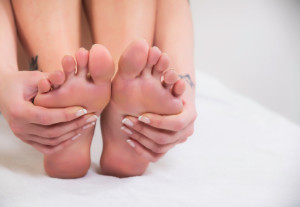 A form of stretching, which is referred to as chair yoga, may be beneficial to practice after sitting and standing for extended periods of time. It can be helpful to stretch the feet in a classroom environment, which can be accomplished by a variety of methods. Heel raises are performed while keeping both heels flat on the floor, and lifting one heel at a time. After holding this position for a few seconds, repeat with the other foot. When the toes and feet are flexible, it may lead to easing tension in the shoulders and neck. This can be a result of utilizing the reflex zones that are located in the feet, and is accomplished by clenching the toes and soles of the feet, and then relaxing them. If you would like additional information about the benefits of stretching the feet, it is suggested that you speak to a podiatrist.
A form of stretching, which is referred to as chair yoga, may be beneficial to practice after sitting and standing for extended periods of time. It can be helpful to stretch the feet in a classroom environment, which can be accomplished by a variety of methods. Heel raises are performed while keeping both heels flat on the floor, and lifting one heel at a time. After holding this position for a few seconds, repeat with the other foot. When the toes and feet are flexible, it may lead to easing tension in the shoulders and neck. This can be a result of utilizing the reflex zones that are located in the feet, and is accomplished by clenching the toes and soles of the feet, and then relaxing them. If you would like additional information about the benefits of stretching the feet, it is suggested that you speak to a podiatrist.
Stretching the feet is a great way to prevent injuries. If you have any concerns with your feet consult with Dr. Robert Marcus from Foot & Ankle Center of Teaneck. Our doctor will assess your condition and provide you with quality foot and ankle treatment.
Stretching the Feet
Being the backbone of the body, the feet carry your entire weight and can easily become overexerted, causing cramps and pain. As with any body part, stretching your feet can serve many benefits. From increasing flexibility to even providing some pain relief, be sure to give your feet a stretch from time to time. This is especially important for athletes or anyone performing aerobic exercises, but anyone experiencing foot pain or is on their feet constantly should also engage in this practice.
Great ways to stretch your feet:
- Crossing one leg over the others and carefully pull your toes back. Do 10-20 repetitions and repeat the process for each foot
- Face a wall with your arms out and hands flat against the wall. Step back with one foot and keep it flat on the floor while moving the other leg forward. Lean towards the wall until you feel a stretch. Hold for 30 seconds and perform 10 repetitions for each foot
- Be sure not to overextend or push your limbs too hard or you could risk pulling or straining your muscle
Individuals who tend to their feet by regular stretching every day should be able to minimize foot pain and prevent new problems from arising.
If you have any questions, please feel free to contact our office located in Teaneck, NJ . We offer the newest diagnostic and treatment technologies for all your foot care needs.
How to Stretch Your Feet
Your feet endure a great amount of stress each day from constantly allowing us to move around. It is important to stretch your feet to help prevent them from becoming injured. Your toes may easily deform into unhealthful positions if they are not stretched.
One of the most common reasons for toe deformities are the shoes you may be wearing. Shoes that are too tight may fold and shift the toes out of place. Heeled shoes may also push your toes upward. Forcing your toes into an unnatural position which may cause the muscles to tighten and prevent them from reverting to normal length. Another common reason is improper use of foot muscles. Many people fail to use the muscles in their feet or toes when they walk. Lastly, the positioning of your feet while walking may also cause toe deformities. If you walk with your feet facing outward, your “push-off” phase is on the side of your big toe instead of the bottom of your foot. This may cause the big toe to eventually tighten into a new shifted position.
There are many reasons why stretching your toes may be helpful. One reason is that healthy spacing may aid in avoiding calluses and other injuries that are caused by rubbing. Stretching will also prevent you from developing toes that curl, hammertoes, or bunions.
A great way to stretch your toes is to place them in your hands and bend them all downward; this will help you stretch the top of your foot. Next, you should repeat this process but instead bend them upward enough to feel a nice stretch in the bottom of your foot. You should then try to pull each toe apart from the next and pull any toes that are bent upward until they are back downward.
If you are looking to practice stretching your entire foot, you can try a towel stretch. This is done by sitting on the floor with your legs in front of you. Take a towel and wrap it around your toes. Afterward, pull the towel toward you with your toes and hold this position for 15 to 30 seconds before releasing. Practice this stretch for three sets. Another stretch your feet are towel lifts. This is done by sitting in a chair and trying to pick a towel up from the ground with your toes. Try lifting the towel with your little toes for five sets before switching feet.
If you are an athlete, or exercise often, it is especially important for you to practice stretching your feet. Those who suffer from foot pain caused by poor footwear, plantar fasciitis, or long hours of standing at work may also benefit from foot exercises.
Which Foot Conditions May Increase the Risk of Falling?
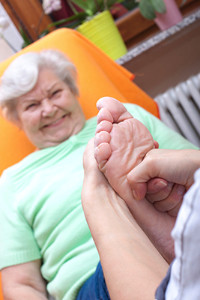 The feet are often considered to be the foundation of the body. However, as we age, we become more vulnerable to developing painful foot conditions. Some of the most common foot complications elderly patients can experience include the formation of corns or calluses, toenail disorders, bunions, hammertoes, poor circulation, and a lack of fat in the pads of the feet. Systemic disorders such as diabetes, osteoarthritis, and rheumatoid arthritis may also increase the risk of developing a foot condition. To help care for elderly feet, it’s important that you perform daily checks for any abnormalities or deformities of the feet. Completing these daily checks may also help reduce the risk of falling. To avoid the risk of getting an infection, the feet should be regularly washed and dried. The nails should be properly trimmed, straight across and not too short, and comfortable and supportive footwear should be worn. If you would like more tips on maintaining the health of elderly feet, it’s suggested that you speak with a podiatrist for professional care.
The feet are often considered to be the foundation of the body. However, as we age, we become more vulnerable to developing painful foot conditions. Some of the most common foot complications elderly patients can experience include the formation of corns or calluses, toenail disorders, bunions, hammertoes, poor circulation, and a lack of fat in the pads of the feet. Systemic disorders such as diabetes, osteoarthritis, and rheumatoid arthritis may also increase the risk of developing a foot condition. To help care for elderly feet, it’s important that you perform daily checks for any abnormalities or deformities of the feet. Completing these daily checks may also help reduce the risk of falling. To avoid the risk of getting an infection, the feet should be regularly washed and dried. The nails should be properly trimmed, straight across and not too short, and comfortable and supportive footwear should be worn. If you would like more tips on maintaining the health of elderly feet, it’s suggested that you speak with a podiatrist for professional care.
Proper foot care is something many older adults forget to consider. If you have any concerns about your feet and ankles, contact Dr. Robert Marcus from Foot & Ankle Center of Teaneck. Our doctor can provide the care you need to keep you pain-free and on your feet.
The Elderly and Their Feet
As we age we start to notice many changes in our body, but the elder population may not notice them right away. Medical conditions may prevent the elderly to take notice of their foot health right away. Poor vision is a lead contributor to not taking action for the elderly.
Common Conditions
- Neuropathy – can reduce feeling in the feet and can hide many life-threatening medical conditions.
- Reduced flexibility – prevents the ability of proper toenail trimming, and foot cleaning. If left untreated, it may lead to further medical issues.
- Foot sores – amongst the older population can be serious before they are discovered. Some of the problematic conditions they may face are:
- Gouging toenails affecting nearby toe
- Shoes that don’t fit properly
- Pressure sores
- Loss of circulation in legs & feet
- Edema & swelling of feet and ankles
Susceptible Infections
Diabetes and poor circulation can cause general loss of sensitivity over the years, turning a simple cut into a serious issue.
If you have any questions please feel free to contact our office located in Teaneck, NJ . We offer the newest diagnostic and treatment technologies for all your foot and ankle needs.
Elderly Foot Care
As you grow older, you will start to notice more problems with your feet due to wear and tear. This may also happen because the skin will start to become thin and lose elasticity. Some signs of aging feet are regular aches and pains, bunion development, and clawed toes.
Fortunately, there are ways you can improve comfort, relieve pain, and maintain mobility in your feet. One of the best ways to deal with aging feet is to exercise. If you keep active, your muscles will become toned which will then strengthen the arches in the foot and stimulate blood circulation.
It is important that you practice proper foot care to protect your aging feet. You should wash your feet in warm water on an everyday basis. Afterward, the feet need to be dried well and it is important to dry between the toes. Your toenails should be trimmed and kept under control; nails that are poorly cut may become ingrown. At the end of each day, performing an inspection of your feet will allow you to detect any ailments in their early stages.
As you grow older, it becomes more important that you wear comfortable shoes. Your shoes should be secure, and they should provide decent arch support. If you are looking to buy a new pair of shoes, it is best to look for a pair that are made from a breathable material. It is also helpful to have shoes that have a bit of extra room at the top of the shoe, especially if you suffer from swollen feet.
The most common foot problems that elderly people will encounter are bunions, calluses, corns, hammertoes, heel pain, and foot problems related to diabetes. Some other issues include arch pain, tarsal tunnel syndrome, Achilles tendonitis, and Morton’s neuroma
An annual foot examination is a great way for you to ensure that you do not have any serious health problems with your feet. You should talk to a podiatrist about the available treatment options for whichever foot issue you are dealing with.



